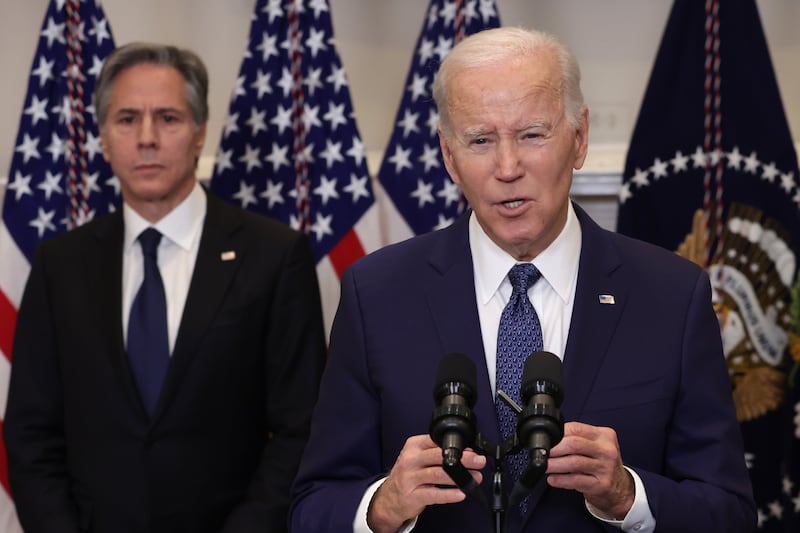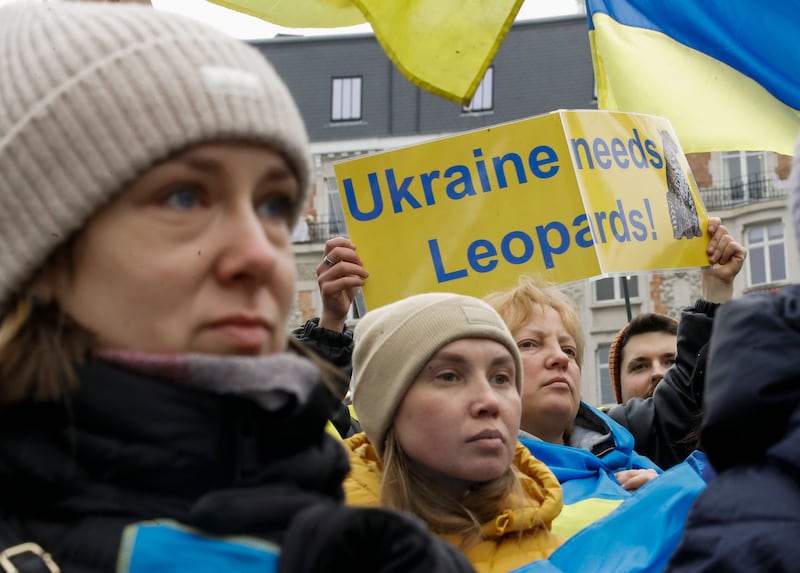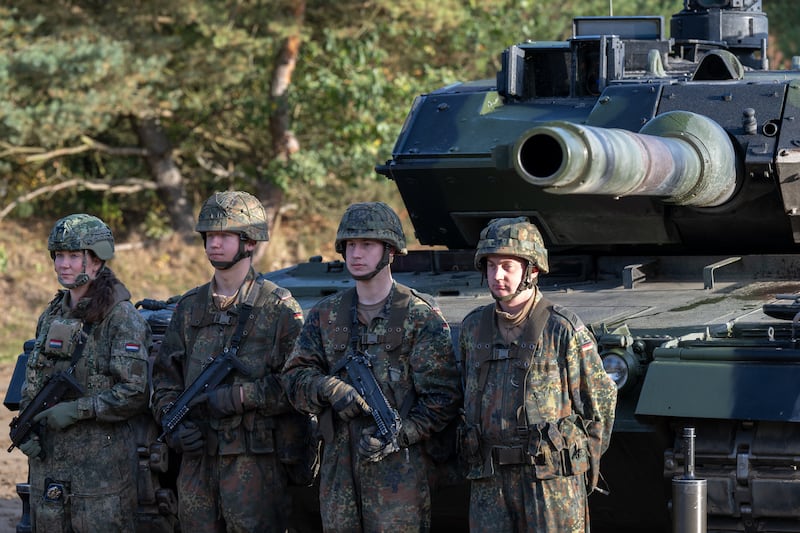Ukrainian soldiers will face a steep learning curve when they clamber into a Leopard 2 tank for the first time next month. But the new tanks will be a serious upgrade from the Soviet-era models they have been fighting in over the past year.
“It’s like you have a car from the 1950s and then you sit in a Porsche,” says a person involved in organising training for Ukrainian troops.
The German government’s decision last week to send Leopard 2 tanks to Ukraine – and allow other European capitals to do the same – will give the Ukrainian army vital new firepower as it sets out to liberate its country from Russian occupation.
With Ukrainian forces having made some decisive advances before winter set in, Kyiv and its allies are now racing to establish the new tank force in time for a possible offensive later this spring.
RM Block
However, it could take several months for the bulk of the force to arrive, and it could be considerably smaller than Kyiv had hoped. Some military analysts fear that western tanks may not prove to be the game changer that many Ukrainians and their supporters imagined – even if the Ukrainians are talking up the potential.
“The question is whether 100, 150 is enough. Well, it’s enough to make a big difference,” says Andriy Zagorodnyuk, a former Ukrainian defence minister.
For months, Berlin and other western capitals had rebuffed Kyiv’s pleas for western main battle tanks, saying they were too difficult for Ukrainian forces to maintain and risked provoking Moscow. After prevaricating for weeks in the face of mounting pressure from allies, German chancellor Olaf Scholz acquiesced after securing a US promise to send Kyiv some of its own M1 Abrams tanks.
[ Germany to send Leopard tanks to Ukraine in major policy shiftOpens in new window ]
The policy shift was another pivotal moment for Ukraine’s allies as they reassess Ukraine’s changing military needs and adjust their own calculations about escalatory risk. It prompted celebrations in Kyiv where the slogan “freeing the Leopards” – the most widely available modern battle tank – has become a proxy for the West’s willingness to stand behind Ukraine all the way to victory.
Ukrainian president Volodymyr Zelenskiy hailed the German and US moves to unlock an international tank coalition as a historic achievement. But he immediately questioned the scale of the commitment. “The key thing now is speed and volume,” he said.
Ukraine says it needs 300 western heavy tanks to seize back its territories. It needs them fast to conduct a widely expected offensive this spring and to help fend off a possible Russian attack before then.
US president Joe Biden laid out the reasons why Ukraine needed modern tanks as he confirmed plans to send 31 M1 Abrams on Wednesday.
“To liberate their land, they need to be able to counter Russia’s evolving tactics and strategy on the battlefield in the very near term. They need to be able to improve their ability to manoeuvre on open terrain,” he said. “And they need an enduring capability to deter and defend against Russia’s aggression over the long term.”

Tactical knowledge
The Abrams may be the fastest mass-produced heavy tank in the world, but it will be slow to arrive in Kyiv. The contingent of 31 is coming directly from the manufacturer using a US government funding facility and could take several months, if not longer, to be deployed. That gives plenty of time for training and potentially a long-term commitment of US armour in Ukraine. But it will count little in the battles of 2023.
In the meantime, Ukraine will receive two battalions of Leopard 2s and one company of British Challenger 2s, making a total of about 100 tanks.
German defence minister Boris Pistorius, who is now leading the effort to assemble a fleet of Leopard 2s from multiple European armies, says they will be delivered to Ukraine in two phases: a first battalion of 40 Leopard 2s, including 14 from Germany, in about three months and a second batch of an older version of Leopard 2s, including 14 from Poland, later on. Spain could end up being one of the largest contributors to this second group, but it intends to draw on older Leopard 2s that have been mothballed and kept in storage for 10 years.
Finland, the Netherlands, Portugal and Canada are also expected to contribute.
Before they can take to the battlefield, there needs to be substantial training not just for tank crew but also for repair, maintenance and sustainment units. Logistical support and supply chains also need to be put in place.
A tank crew will require a minimum of five to six weeks of basic training, according to the International Institute for Strategic Studies. But Ukrainian forces have shown they can adapt quickly to multiple weapons systems provided by the West.
“Ukrainian soldiers are known as fast-learners,” says Oleksiy Melnyk, co-director of the Razumkov Centre think-tank in Kyiv. After a year of war, Ukraine now has some of the most experienced tank operators in the world.
However, making use of the new tanks is not just about acquiring the technical knowhow. It will also require tactical training – learning how to exploit the advantages of western battle tanks such as their superior armour, firing range and targeting.

To make the most of the firepower and to offset their vulnerabilities, tanks need to integrate with infantry, artillery, air defence and electronic warfare systems – so-called combined arms manoeuvre. The US began combined arms training for Ukrainians at its Grafenwoehr training area in Bavaria this month.
“There are some units of land forces which are already operating as combined arms groups,” says Zagorodnyuk. “So it’s not like Ukraine will start completely from scratch. But there is a lot of learning that needs to take place.”
Ukraine’s allies are not just donating tanks but hundreds of infantry fighting vehicles, self-propelled howitzers and other artillery pieces. This gives Ukraine the opportunity to learn how to integrate all this new equipment into offensive operations – assuming it can spare enough troops from frontline duties.
“It means we can train coherent units at the same time,” says Yohann Michel, of the IISS. “We need to make sure the Ukrainians can make the best use of it.”
Co-ordinating donations of tanks, artillery, armoured vehicles and the training to combine all three would require a “very, very heavy lift” by Ukraine and its allies, according to Mark Milley, America’s top general.
Ukrainian officials have been vocal about their desire to launch a spring offensive while it has momentum and before Russia has a chance to regroup and train the hundreds of thousands of troops it has mobilised.
Avenues of attack
Western officials and many analysts expect Kyiv to try to regain the initiative and exploit the heavy losses that Russian forces appear to have suffered in the fierce battles around Soledar and Bakhmut in eastern Ukraine. However, it is unclear how many casualties Ukrainian forces have also sustained in the fighting around Bakhmut and how many additional troops Kyiv has kept back for a counter-offensive. Military experts contend that for an offensive to succeed, attacking troops need to outnumber defensive ones by three to one.
One place where Ukraine could try to attack is along the Svatove-Kreminna line, a stretch of the front in the Luhansk province. A major breakthrough there could threaten Russia’s north-south supply routes to its forces trying to seize the rest of Donetsk province – one of Vladimir Putin’s main objectives for the war.
[ ‘Better late than never’: Germany supports Scholz battle tank decisionOpens in new window ]
A much bigger prize for Kyiv would be to push southwards into Zaporizhzhia province all the way to the Azov sea, severing Russia’s so-called land bridge to occupied Crimea.
Either of these directions would be through open terrain, where mechanised force would be indispensable, as opposed to the more urbanised Donetsk province.
But the Russian defensive lines along both of these axes are likely to be more formidable than anything that Ukraine has so far overcome. In the meantime, it could be the Russians who attack first. Moscow has been holding back about half of the 300,000 troops that it mobilised in the autumn and, having given them some training, they could be more effective than the first 150,000 thrown into the fight.
“Heading into 2023, Ukraine no longer has a manpower advantage and difficulties lie ahead,” says Michael Kofman, director in the Russian studies programme at CNA, a think-tank. “This will require large numbers of armoured fighting vehicles and to a much lesser extent tanks. Consequently it is a numbers game, where more is more.”

Mykola Bielieskov, an analyst at Ukraine’s National Institute for Strategic Studies, says tanks integrated with artillery and infantry would be vital to any Ukrainian offensive or defensive operation. How many western tanks Ukraine needs depends on the sequence of events on the battlefield, he says. If Russia attacks first and is then weakened, giving Ukraine a counter-attacking opportunity, Kyiv will need fewer. If Ukraine embarks on its own offensive, it would need more because it would first need to break through enemy lines and then conduct a second phase of enveloping and destroying Russian troops.
Seizing a defensive position ultimately involves getting infantry into trenches, says Rob Lee, senior fellow at the Foreign Policy Research Institute, adding that the key is getting your soldiers across open terrain protected from artillery fire. “It hasn’t really changed that much in warfare since the second World War or before that.”
“In some ways the deliveries of Bradleys, or Marders or Strykers and those types of [infantry fighting] vehicles may be even more significant,” says Lee. The upgrade in Ukrainian capability from a Soviet-era armoured vehicle to a US-supplied Bradley may be greater than that from a shift from T-72 to Leopard tank.
“We shouldn’t jump to conclusions that tanks by themselves will win this war,” he says. “But they are an important contribution, and they’ll give Ukraine a better chance of success in 2023 and in 2024.” – Copyright The Financial Times Limited 2023






















